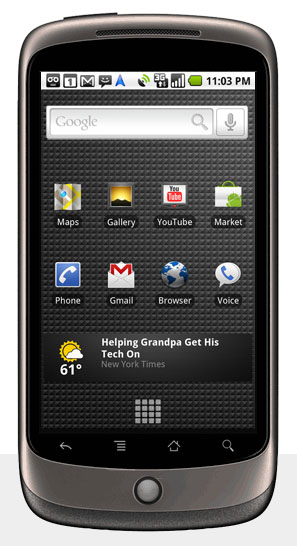At a press event at its California headquarters today, Google formally unveiled its first phone, the Nexus One. The device has been the subject of rumors, speculation, and leaked specifications ever since Google employees began telling the world they were testing Google phone hardware—and Google’s formal introduction of the phone came with few surprises…except perhaps that Google prefers to think of it as a “superphone” rather than a “smartphone.” Google is positioning the Nexus One as the first in a series of Google-branded mobile devices…and is clearly taking a long-term approach to the mobile device market—and will be selling the phone itself through a brand-new Web-based store—which, of course, is powered by Google Checkout.

The Nexus One was designed in close partnership with Taiwan’s HTC, and represents Google’s first effort to work with a hardware partner to design an Android-powered phone from the ground up and explore some of the possibilities offered by both the Android operating system and advances in mobile technology. Google characterizes the Nexus One as a device “where Web meets phone,” and aims to bring an Internet-enabled experience to almost every aspect of using a mobile device.
On the hardware front, the Nexus One sports a speedy 1 GHz Snapdragon processor from Qualcomm and a large 3.7-inch, 800 by 480-pixel AMOLED display, along with a 5 megapixel video-capable camera with an LED flash. For navigation, the Nexus One sports a trackball for navigating the interface and menus, and the trackball doubles as a notification light, shining different colors (blue or white) when calls, notifications, and messages come in. The Nexus One sports a full bank of proximity, light, and motion sensors, along with an integrated assisted GPS receiver and a compass, plus two microphones (front and back) to support active noise cancellation technology. The camera can capture video in MPEG4 format—ideal for uploading to Google services like Picassa and YouTube, naturally—and, in addition to 3G connectivity, sports 802.11b/g/n WiFi and stereo Bluetooth wireless technology. The device has 512 MB of flash storage and supports microSD cards for storage.
The Nexus One will also ship with Android 2.1—which means it offers full support for services like Gmail and is ready to tie in with social networking services like Facebook and Twitter. The Nexus One also comes with some Google enhancement, including five homescreen panels (rather than just one) for faster access to common applications and tools, a bundle of new widgets (including a tool that uses the integrated GPS for up-to-the-minute weather info for the phone’s location), and live desktop wallpapers that can display motion and animation. Google’s presentation also leverages 3D capabilities of the phone’s graphics chip, tilting icons and imagines on an imaginary Z axis for…no discernible purpose.

The Nexus One also makes extensive use of voice recognition: basically, anywhere a user could enter text, they may also speak to have the Nexus One take its best guess at what the user wants. Voice recognition can be used with text messages, email, social networking updates, the built-in GPS and mapping applications. Apparently the speech recognition processing runs on Google servers—so good luck trying to use it if you’re out of range—but it seems like a genuinely useful enhancement for on-the-go people who might be able to, say, respond to email while driving, cooking, or doing something else when their hands are occupied. The speech recognition system learns a user’s individual speech patterns and improves with time.
Google also demonstrated a functioning version of Google Earth for the Nexus One.
Google is offering the Nexus One through its new Web store, both in unlocked and a carrier-subsidized version from T-Mobile; Google plans to expand the store to include other Android-based devices, both carrier-subsidized and unlocked, from a number of manufacturers and operators in many countries. For now, the store is offering the Nexus One for $529 without service, or $179 with a new two-year contract from T-Mobile. Verizon and Vodaphone will apparently join T-Mobile in offering the Nexus One in “spring 2010.” The Nexus One is only available in the United States, but the device will apparently be available in three test markets: Singapore, Hong Kong, and the United Kingdom.
Google’s decision to launch its own Web-based store for Android devices is no doubt good for the Android platform: it can put the muscle of Google’s brand recognition behind a variety of devices from a number of operators around the world. However, Google’s decision to step into the market as a hardware developer in its own right—it plans to continue working with HTC on future Google devices, as well as with other partners like Motorola—may also put a damper on the Android ecosystem. Although Android is an open source platform with simple licensing, Google is in a unique position in terms of advancing the platform and develop hardware it wants to use with Android. That makes Google’s stance with the Nexus One and subsequent devices more akin to the approach taken by the likes of Apple, RIM, and Palm—control both the hardware and the OS—rather than systems like Symbian or Windows Mobile.
Check out our Nexus One photo gallery
Editors' Recommendations
- The best Android tablets in 2024: the 11 best ones you can buy
- 5 smartwatches you should buy instead of the Google Pixel Watch 2
- A new Google Pixel Tablet is coming, but it’s not what you think
- The most common Google Pixel 8 problems and how to fix them
- How to get Android apps on a Chromebook
